The data captured by NASA‘s New Horizons space probe that past Pluto in June 2015 provides evidence that the dwarf planet may still have liquid buried beneath its glacier crust.
Pluto never ceases to amaze with every discovery. The space probe’s latest finding suggests that contrary to what the research led by the Ph.D. student in Earth, Environmental, and Planetary Sciences Noah Hammond initially inferred, Pluto is expanding due to the liquid it still contains trapped within the planet’s depth.


An important part of this case is a type of frozen water called ice II, which is 25% denser than that on Earth. The idea is that Pluto’s water has been completely frozen, and it would be comprised of ice II, which as a result would have made the planet contract. “We don’t see the things on the surface we’d expect if there had been a global contraction, so we conclude that ice II has not formed, and therefore that the ocean hasn’t completely frozen,” Hammond stated.
One of the probabilities of such data was linked to a possible “tug of war” the planet may have had with its moon, Charon. However, such gravitational pulls would have wound down long ago, whereas the faults in the images taken by the space probe suggest that they are more recent. This then led researchers to consider another probability of Pluto having a subsurface liquid ocean.
The unraveling mystery that is Pluto has an exotic surface composed of water, nitrogen and methane as well as sinuous faults hundred kilometers long and four kilometers deep visible among its tectonic plates. It is precisely these tectonic features which point to the possibility of a subsurface ocean. Furthermore, researchers believe that there may have been heat-producing radioactive elements on the planet’s rocky surface that kept it from completely freezing.
Pluto was once viewed as a small, old and distant ball of ice accompanied by its moon in the Kuiper belt. Due to New Horizons findings, scientists now realize that there has been a tectonic activity that suggests that there is a probability that there might have been life on the remote planet millions of years ago.
Hammond explained that Pluto’s exotic ice may be acting as an insulator, preventing the dwarf planet from losing its heat, thus keeping its subsurface water in liquid form. This means that under hundreds of kilometers of ice and rock, there may still be liquid water on the planet that no space probe has managed to perceive.
“The possibility that you could have vast liquid ocean habitats so far from the Sun on Pluto — and that the same could also be possible on other Kuiper belt objects as well — is absolutely incredible,” Hammond exclaimed.
Hammond and his team have updated the thermal evolution model for their study based on what the space probe had found, which include: the density and diameter as well as key elements explaining the planet’s internal parameters. Due to the high pressure and low temperature within Pluto, if the subsurface ocean had frozen into ice as we know it, it would have quickly converted into ice II; however because this was not the case, the assumption is that not all the water has in fact frozen.
Researchers had believed that Pluto’s ice shell was 260 kilometers thick, but the findings have made them reconsider the distance to more than 300 kilometers before penetrating the core to where the ocean is believed to have once been or where it can currently be found. This is truly astounding for the formerly known ‘heart-shaped plain.’ This is groundbreaking evidence for the controversial planet non-planet. It also pushes researchers to investigate how life could be on other planets in a manner different to our own.
Another incredible finding, proving once again that outer space activity is nothing shy of incredible.
Source: Gizmodo
